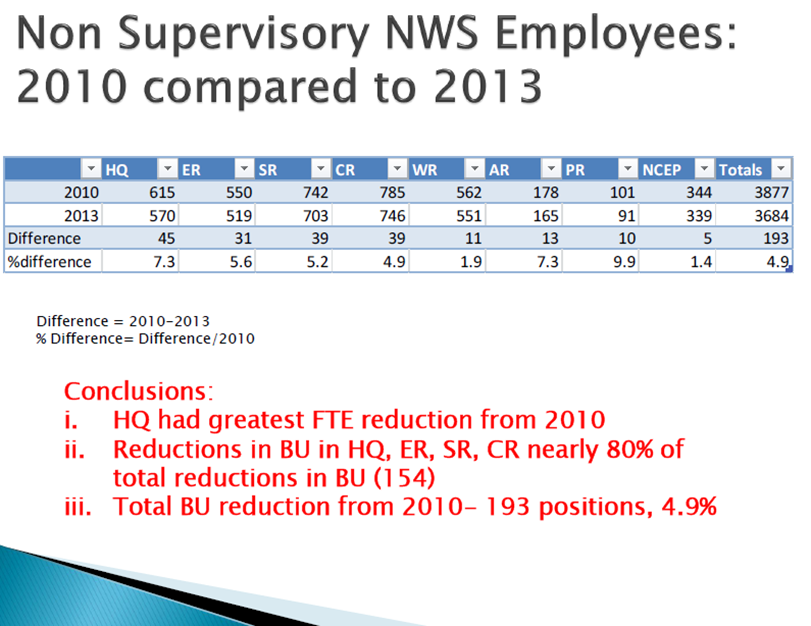NWS Feels the Effects of a Vacancy Rate that Exceeds Eight Percent
(March 21, 2013) Lead forecasters are filling in as ASAs. Offices are scrambling to schedule employees who are certified for upper air launches due to vacant intern/HMT positions. Critical drought conditions are covered on an ad hoc basis, services are degraded, and there are potential safety impacts to general aviation. National Weather Service vacancies bring the term “multi-tasking” to new levels in an ominous way and fatigue the employees we depend on to stay alert.
The bargaining unit reports from January shows there are 193 more vacancies in NWS bargaining unit positions than there were in 2010.

The latest data from March shows nine additional vacancies for a total of 202 more vacancies from the already short (fair weather) staffed NWS in 2010. This reflects a lapse labor rate that exceeds eight percent – up from 2.8 percent in 2010. This does not include vacancies (which are many) in management positions that are often used to fill in for the vacant operational employees.
“With the tornado season beginning and the hurricane season right around the corner, we have great concern about the ability of our offices to provide the most accurate forecasts and warnings during severe weather when so many offices are currently staffed below fair weather staffing requirements,” said Dan Sobien, NWSEO President. “Keep in mind these numbers do not include people on extended leave for medical emergencies or other reasons,” Sobien added.
Even on fair weather days, offices report overtime and temporary promotions to fill the gaps leaving forecasters fatigued from working off rotation shifts or shifts with a quick turnaround. In one office, it was called, “a scheduling nightmare in which no one works their regular schedule anymore.”
“In the past people were expected to change their shifts from midnight to day on a weekly basis. Now they’re being asked to work night shift, switch to a day shift, and then switch back to a night shift in the same week. It’s taking an unhealthy toll. They’re going to put their employees in a hospital if it continues,” Sobien stated.
Leave, training, equipment maintenance, and outreach have become casualties of the staffing shortage adding undue burden to the dedicated employees who work to maintain the agency’s mission of saving lives and property. Morale is reported to have dipped “off the chart” to a new low across the agency.
The most frequent issues reported to NWSEO from WFOs around the country with a range of one to five vacant positions include:
- Forecasters (making $95k/yr.) covering ASA shifts (approx. $50k/yr.). In at least one case the MIC (approx. $130k/yr.) filled in for the vacant ASA position.
- Many offices have curtailed or eliminated most outreach activities in some case losing opportunities for synergy with other agencies forever.
- Critical drought conditions duties in one office is covered on an ad hoc basis due to a service hydrologist vacancy causing a degradation of service.
- DAPM and forecasters take over responsibilities of HMTs and interns (Upper air runs). One upper air site will soon have all of their intern/HMT positions vacant and is scrambling to find certified employees to do launches.
- Significant additional workload as some forecasters and ESAs scramble to fill in the work of ITOs. In some cases forecasters are forced to fill in as ITOs that have little or no computer training causing significant impacts to computer development and security programs “computer updates working with bubblegum and bailing wire!”
- ESA covering all of the work of vacant El Techs positions causing concern if there is a radar outage during a severe weather outbreak.
- Two incidents of MICs splitting duties between two WFOs – one says they have an MIC only 40 percent of the time.
- Forecasters working more than half their shifts as midnight shifts causing extreme wear and tear, not to mention health and family issues.
- Vacant Radar Support Team Lead means no formal management at lowest level for hotline operations
- Employees will have leave denied during peak leave periods. If vacancies continues into warm season it will severely hamper mandatory COOP, SAWRS, LAWRS and marine wind site inspections which could have a significant impact on the safety of general aviation.
- Mandatory training in many offices is being put on hold as the forecasters and OPLs are filling vacant HMT/intern positions.
- The combination of OPL and intern vacancies took one office’s normal 5 person DATAC rotation down to 1. Managers have filled as many shifts as possible as well as other forecasters, but have had to do without a DATAC shift at times to get by, causing the short term/ESTF forecaster to cover the observation desk.
During the past week, NWSEO has filed grievances over vacant positions for lead meteorologists, journeyman forecasters, HMTs and interns, and ITOs. The union has also filed a grievance over the agency’s unilateral change in the practice of paying relocation expenses for Interns and HMTs.
“The number of vacancies has more than doubled since 2010. The National Weather Service has to do better. People’s lives depend on it,” said Sobien.
NWSEO Vacancy Grievances
Lead Forecaster
HMT/Interns
ITO
Journeyman Forecaster
PCS relocation fees
-NWSEO-
